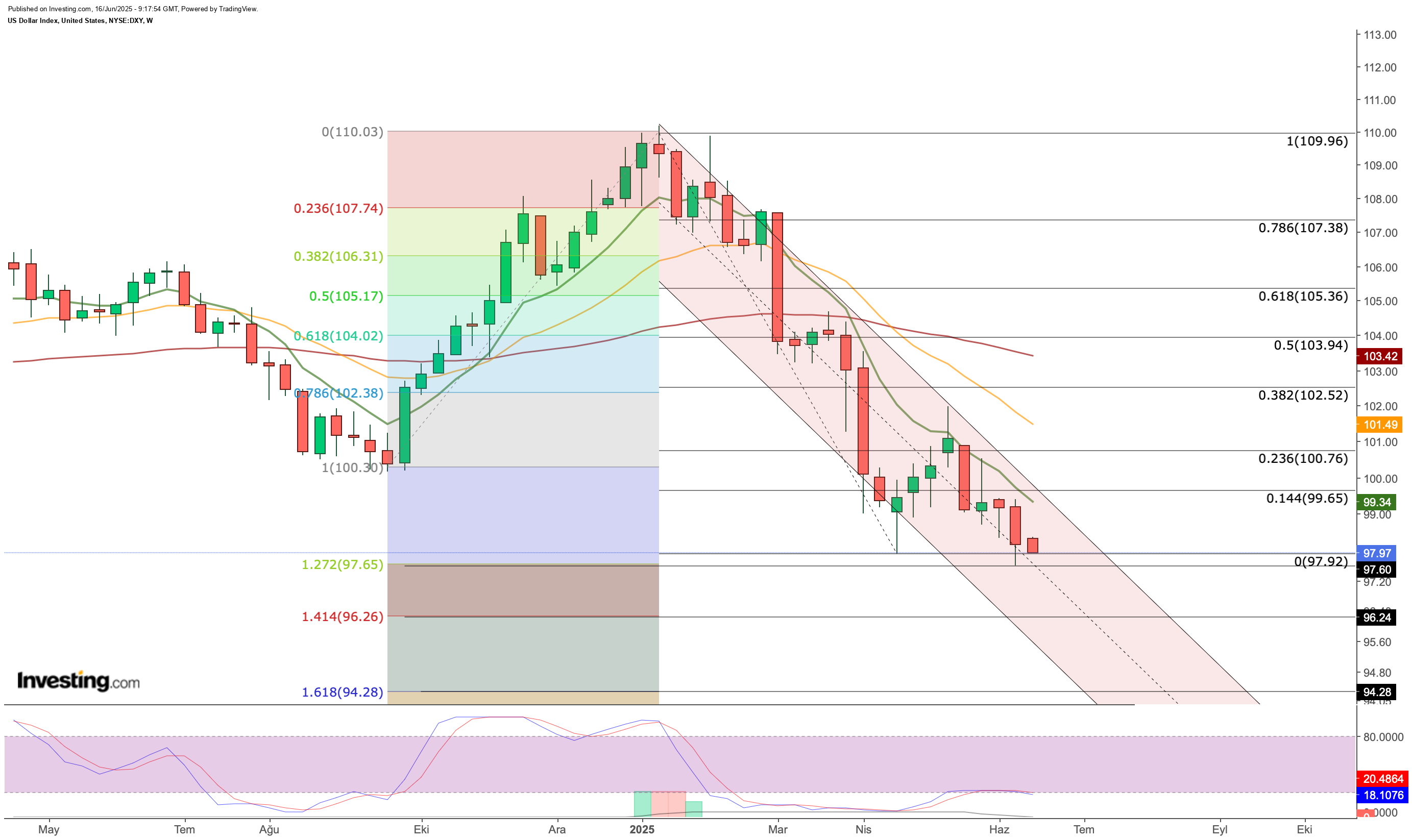Micron to exit server chips business in China after 2023 ban- Reuters
- US dollar holds near 98 amid geopolitical risks and a cautious Fed outlook.
- Markets watch Fed projections, energy prices, and G7 signals for the dollar’s next move.
- Technical indicators show weakness; a break below 97.65 may deepen the downtrend further.
- Looking for actionable trade ideas to navigate the current market volatility? Subscribe here to unlock access to InvestingPro’s AI-selected stock winners.
US Dollar started the week on a weak note but has been trying to stay near the 98 level since last week. There has been some buying just below 98, but it has not been strong. Rising geopolitical tensions and a sudden jump in oil prices are driving safe-haven demand and raising concerns about supply shocks.
The main focus is on the increasing attacks on energy infrastructure between Israel and Iran. This conflict could impact not just the Middle East but global demand for the dollar as well.
Iran’s threat to close the Strait of Hormuz puts about one-third of global oil trade at risk. This could push inflation higher again, which is worrying for markets.
If inflation rises, the chances of the Federal Reserve cutting interest rates in the near future may drop. Higher energy prices could make it harder for the Fed to meet its goal of price stability, leading policymakers to wait longer before making any changes.
Fed’s Interest Rate Strategy
Interest rates are expected to stay the same at the Fed meeting on Wednesday. However, the key focus will be on the Fed’s updated economic projections and the wording in its statement. The main question for the dollar is whether the Fed will signal any rate cuts before the end of the year.
Weak employment and growth data from the US have led markets to expect a possible rate cut in September or December. But rising geopolitical tensions and the recent increase in energy prices have slightly delayed these expectations. As a result, markets now see almost no chance of a rate cut in July.
This week’s manufacturing data, retail sales, and unemployment claims will be closely watched. These reports may influence the Fed’s tone. If the data is stronger than expected, it could lead to more strength for the dollar.
US Dollar Outlook Still Fragile
Although geopolitical risks are giving the US dollar some short-term support, the overall outlook for the dollar remains weak. The US Dollar has fallen more than 10% from the 110 level seen earlier this year, and it keeps losing value, especially against EUR/USD and the currencies of commodity-exporting countries.
To be sure, the euro has gained strongly due to the European Central Bank’s cautious approach to cutting interest rates. Meanwhile, currencies like the USD/NOK have benefited from higher energy prices.
At the same time, President Trump’s expansionary fiscal policies, tax cuts, and possible new tariffs could worsen structural issues in the US economy and hurt confidence in the dollar. This may increase the risk of a larger external deficit and raise questions about the dollar’s status as the world’s reserve currency.
In summary, while the dollar gets some short-term support from geopolitical risks and the Fed’s cautious approach, key indicators still suggest a fragile outlook. The US dollar is trading around a critical support and resistance level near 98. If it manages to stay above this level, a short-term rebound may happen. However, in the longer term, the dollar is likely to remain under pressure due to trade imbalances and expectations of rate cuts.
Investors will watch not only the Fed’s decision but also developments in energy prices and geopolitical signals from the G7 Summit. In this period of weak global risk appetite, the dollar’s direction will depend both on US policy and political risks around the world.
Technical Outlook for the US Dollar

The US dollar is still struggling to hold a key support level as its downward trend continues from earlier this year. Based on the recent upward move, the index has now reached the Fibonacci 1.272 level at 97.65.
This zone can be seen as an expansion point in the trend. If the US dollar closes below 97.65 on a daily basis, the decline may continue towards 96.25 and then 94.25.
However, if support at 97.65 holds, the 99.65 level could become important for any short-term rebound. A move above this resistance might signal rising dollar demand, with the potential to push the index toward the 100-102 range. Still, technical indicators are showing weakness in dollar demand for now. As long as the index stays below 99, the risk of further declines remains.
***
Be sure to check out InvestingPro to stay in sync with the market trend and what it means for your trading. Whether you’re a novice investor or a seasoned trader, leveraging InvestingPro can unlock a world of investment opportunities while minimizing risks amid the challenging market backdrop.
Subscribe now and instantly unlock access to several market-beating features, including:
- ProPicks AI: AI-selected stock winners with a proven track record.
- InvestingPro Fair Value: Instantly find out if a stock is underpriced or overvalued.
- Advanced Stock Screener: Search for the best stocks based on hundreds of selected filters and criteria.
- Top Ideas: See what stocks billionaire investors such as Warren Buffett, Michael Burry, and George Soros are buying.

Disclaimer: This article is written for informational purposes only. It is not intended to encourage the purchase of assets in any way, nor does it constitute a solicitation, offer, recommendation or suggestion to invest. I would like to remind you that all assets are evaluated from multiple perspectives and are highly risky, so any investment decision and the associated risk belongs to the investor. We also do not provide any investment advisory services.
